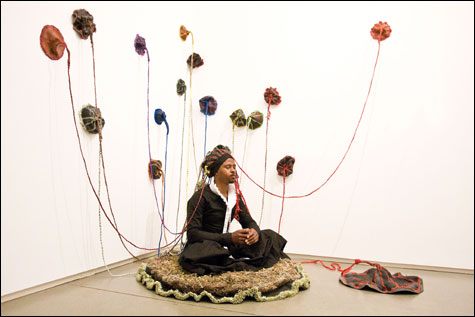
THOBA, UTSALE UMNXEBA When he finished his performance, it seemed Hlobo could use a hug.
The South African artist Nicholas Hlobo quietly walked into the hallway at the Institute of Contemporary Art, sat down in a corner on a nest of curry bush, and put on a black headdress or crown that was connected by braided cords to plant-like suction-cup-looking things clinging to the walls. The July 29 performance, Thoba, utsale umnxeba (in Hlobo’s native Xhosa language it means “to lower onself and make a call,” or, as the wall text described it, a “gesture of respect and diplomacy”), was part of his new exhibit at the Institute of Contemporary Art. “It’s about the idea of communication,” Hlobo says of his act when I telephone the next day. “I was trying to make some sense of the space and the idea of the space, the museum, the gallery, the location of the museum, the culture — the culture is almost foreign to me.”
He sat on the circular nest and fussed for a long while with the hat, adjusting its fit over his dreadlocks, shifting the red tassels on the side, and pulling on his goatee. Then he settled into a long silent sit, seeming to meditate, eyes closed and then open, rocking forward and then sitting upright again, repeat. VIPs arrived for the show’s opening reception, watched him for a while, then wandered into the gallery to see the rest of his art and chat.
The exhibit, “Vula zibhuqe” (which means “to turn a blind eye”), was organized by ICA associate curator Jen Mergel. The 11th in the ICA’s Momentum series, which showcases emerging artists from around the world, it features the props and the costume from Hlobo’s performance, a soft sculpture, and two “drawings” in colored satin ribbons stitched into 10-foot-wide sheets of white paper. Pink scrims, placed over ceiling lights to give the gallery a fleshy feel, make the room seem murky, underwater.
“In my works,” the 32-year-old Johannesburg resident explains, “I celebrate my identity as a South African, a gay man, a Xhosa man, which is my ethnic identity, and I also celebrate my colonial heritage.”
The best piece here is Umphanda ongazaliyo (2008), an 18-foot-long black sack made from old-rubber-tire inner tubes, with pink ribbon stitched along ribs that run from its head to tail. Veins of colored ribbon wander the surface. Pockets and protrusions grow along the sides and the bottom. Metal nozzles sprout from the skin. The whole thing dangles from the ceiling by wires. A tube tail burrows into a gallery wall, with a ring of pink fringe, and emerges on the other side as a large black “orifice” — as the wall text politely describes it.
“ ‘Umphanda’ means ‘the vessel,’ ‘ongazaliyo’ means ‘that never fills up,’ ” Hlobo goes on. He describes the sculpture as a stomach that symbolizes all-consuming greed, hunger, gluttony, selfishness. “That’s why the whole world is at war, because there is a need to feed the stomach.”
But that’s not what the sculpture projects. It’s a big, curious, floating object, a leaping whale, a flying squash, a makeshift anatomy display, with a bit of carnival atmosphere. Peer through one of the peepholes (ulcers?) along its side and you see dangling ribbons and dots of light shining in through the stitching. The interior resembles a twinkling night sky.